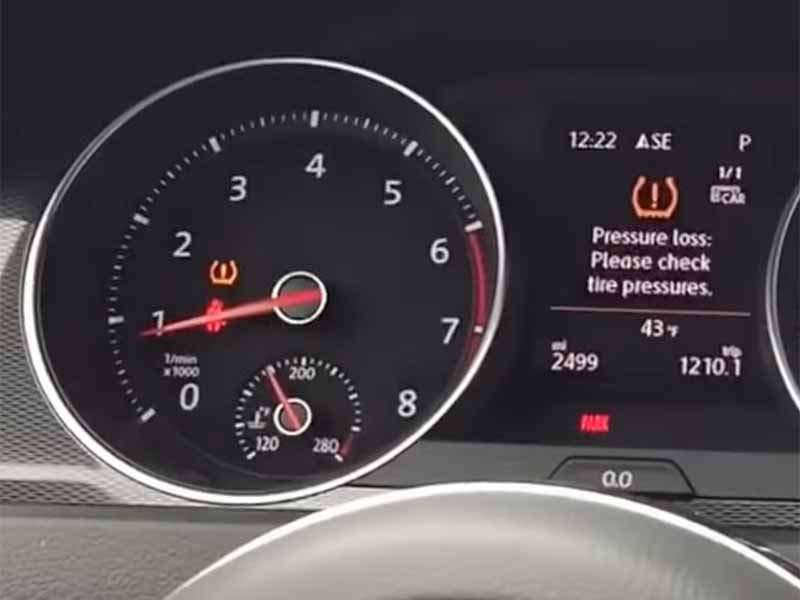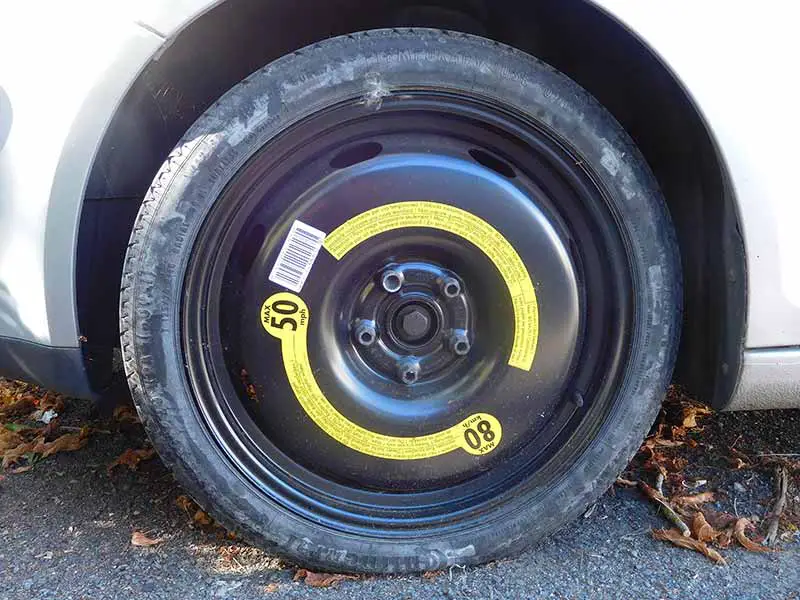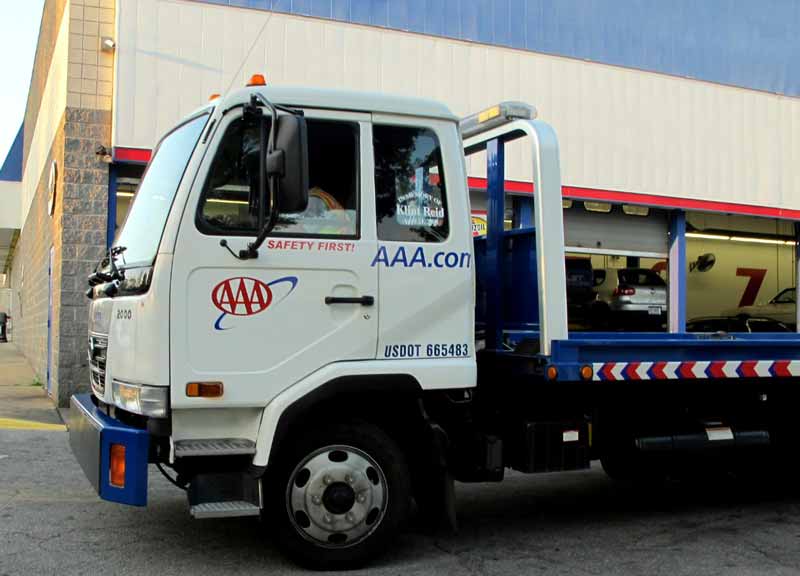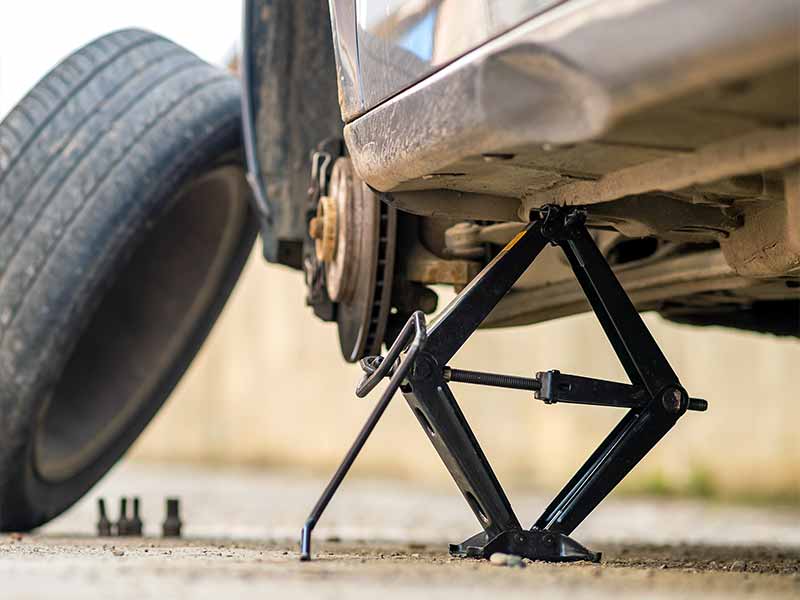It’s not a matter of if you get a flat tire, but when. If you drive long enough, you’ll see the low tire pressure warning light on your instrument cluster.

It’s a bad idea to try to drive on a flat tire, but don’t worry. We’ll walk you through all the options to safely get you back on the road.
What To Do When You Have A Flat Tire
- Ease your car to the side of the road, away from the flow of traffic
- Turn on your hazard lights to alert other drivers
- If you have a spare tire, follow the instructions in your owner’s manual to change the tire
- If you have an inflation kit, follow the instructions on the kit to seal and inflate the tire
- If you have run-flat tires, reduce speed to below 50 mph and drive no further than 50 miles
- If there are issues with these methods, call roadside assistance, a tow truck, or a friend
Now that we’ve covered the different options and situations, we need to give you detailed instructions for your particular situation.
Let’s take a closer look.
How To Change A Flat Tire If You Have A Spare
Changing a flat tire can be daunting if you have never done it before, but it is a simple process you can do with a little know-how.

How to change a flat tire:
- Park on flat ground and away from traffic. Turn on your hazard lights to alert other drivers that you are stopped on the side of the road. Avoid soft grass or other ground that would make a jack unstable.
- You will need a lug wrench (also called a tire iron), a jack, and a spare tire. These should be located in your trunk.
- It is important to loosen the lug nuts before jacking up the car, as it will be easier to turn the wrench when the tire is still on the ground.
- Place the jack in the designated jacking point and pump the handle until the vehicle is high enough off the ground for you to remove the flat tire. Consult your owner’s manual to find the proper jacking point for your car.
- Once the car is high enough, remove the lug nuts and take the flat tire off.
- Line up the holes in the spare tire with the bolts on the car and secure it using the lug nuts. Tighten the lug nuts as much as you can by hand.
- Lower the vehicle enough for the tires to touch the ground to prevent them from spinning, and use the lug wrench to properly tighten the lug nuts.
- Once the spare tire is secure, lower the vehicle completely back to the ground.
- Ensure the spare tire is properly inflated to the recommended pressure listed in your owner’s manual or the tire information sticker in your driver’s door jamb.
- As soon as possible, get the flat tire repaired or replaced. Avoid driving on a spare tire for more than 50 miles, drive cautiously, and avoid high speeds.
How To Fix A Flat Tire With A Tire Sealant
If you don’t have a spare, your car or truck may have come with an inflation kit that includes a tire sealant. If you don’t have an inflation kit, which is usually a combination of air compressor and tire sealant, you can have a friend bring you these items from your local auto parts store or a large store like Walmart.

Tire Inflation Kit Example
A tire sealant is a temporary fix for a flat tire. It is designed to seal small holes or punctures in a tire, allowing you to drive on the tire until you can get it repaired or replaced.
Here’s how to use a tire sealant:
- Different tire sealant sprays may have slightly different application instructions, so be sure to read and follow the instructions provided by the manufacturer.
- The tire sealant is a liquid that needs to be mixed thoroughly before use. Shake the can well to ensure that the sealant is mixed correctly.
- Hold the can upright and press the nozzle to inject the sealant into the tire. The sealant will automatically mix with the air in the tire as it is injected.
- Use an air compressor to re-inflate the tire to the recommended pressure. Check the tire pressure with a gauge to ensure it is at the correct level.
- If the tire doesn’t hold air, you may need to drive forward and backward just enough to spread the sealant inside the tire to the leak.
- Tire sealant is a temporary fix and is not meant to be a permanent solution. Drive cautiously and avoid high speeds until you can get the tire properly repaired or replaced.
How To Fix A Flat Tire With A Plug Kit
An alternative to using tire sealant is to use a tire plug kit. Plug kits are a little more difficult to use but can seal “slightly” larger punctures than a sealant can seal.

Tire Plug Kit Example
Here’s how to use a flat tire plug kit:
- You will need a flat tire plug kit, a tire pressure gauge, a tire iron, and a compressor or hand pump.
- Determine where the hole is located. Look for foreign objects stuck in the tire or add air to the tire and listen for the hissing sound of an air leak.
- Use the included hole reamer to widen the hole slightly. This will help the plug kit work more effectively.
- Follow the manufacturer’s instructions to insert the plug into the puncture. Some kits may require you to apply a small amount of glue or cement to the plug before inserting it.
- Use a compressor or a hand pump to re-inflate the tire to the recommended pressure.
It is important to note that a flat tire plug kit is only a temporary fix and is unsuitable for all tire damage types. If the damage to your tire is too severe, you will need to have the tire repaired or replaced by a professional.
What To Do If You Have A Flat With A Run-Flat Tire
Run-flat tires make it possible to keep driving even if the tire has lost all of its air pressure. This can be a convenient feature, as it enables you to drive to a safe location to have the tire repaired or replaced rather than changing it on the side of the road.
However, it is essential to be aware of the limitations of run-flat tires and to follow a few basic guidelines if you have a flat with a run-flat tire:
- All vehicles with run-flat tires require a tire pressure monitoring system (TPMS). Your TPMS should alert you if the tire pressure in one of your tires drops significantly.
- If one of your tires is significantly lower than the others, you should pull over and check for a puncture or other damage.
- Run-flat tires allow you to continue driving at reduced speeds (usually up to 50 mph) for a limited distance (usually up to 50 miles). However, you should drive cautiously and avoid high speeds, hard braking, and sharp turns to minimize the risk of further damage to the tire.
- If you have a flat with a run-flat tire, you should get the tire repaired or replaced as soon as possible. Run-flat tires are not meant to be driven on indefinitely.
Who To Call When You Have A Flat Tire And Can’t Fix It Yourself
If you have a flat and aren’t comfortable changing it yourself, or if you don’t have a spare tire, there are a few options for getting help:
- You can call a tow truck to take your car to a repair shop or other safe location.
- If you have a roadside assistance plan, you can call the number provided to request assistance with a flat tire. Most roadside assistance plans include tire change service, so they can send a technician to change your tire for you.
- Many auto repair shops offer mobile tire repair services that can come to your location to fix a flat tire. You can search online or call around to local shops to find a service that can help you.
- If you don’t have roadside assistance and you don’t know of any mobile tire repair services in your area, you can call a friend or family member for help. They may be able to bring you a spare tire or assist you with changing the flat tire themselves.

Photo Credit: frankieleon via Flickr
It is important to note that driving on a flat tire is dangerous and can cause further damage to your vehicle. If you cannot fix the flat tire and do not have a spare, it is best to call for help rather than try to drive on the flat tire.
Resources
Below are some links you may find helpful when learning about tires
Final Thoughts
A flat tire is an inconvenient and unfortunate situation. But it doesn’t have to be overwhelming.
Often, you can fix a flat tire. But if you drive any distance with no air pressure, your tire will need to be replaced and the wheel it’s mounted out can quickly become damaged. If you try to drive with a flat tire, not only is it dangerous, but it’s an expensive mistake.
You shouldn’t drive on a flat tire unless it’s an emergency. And you should only drive as far as necessary to get to safety and do so as slowly as possible.
Good luck and happy motoring.





